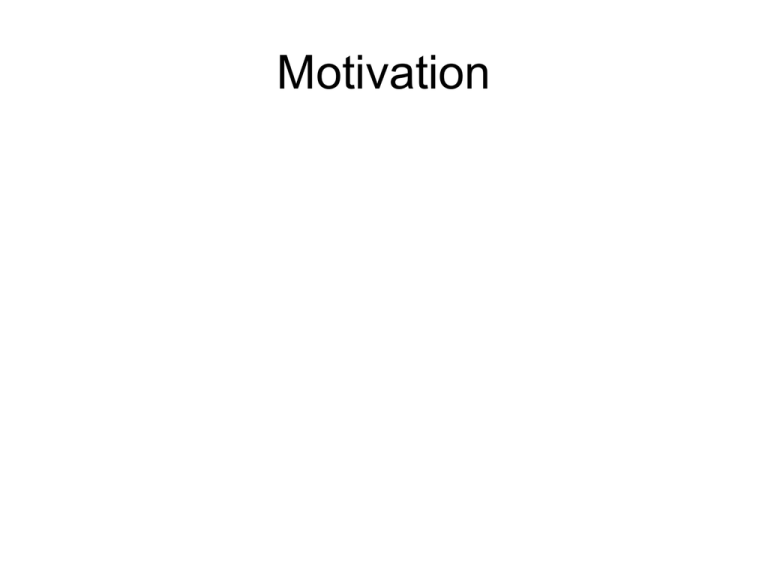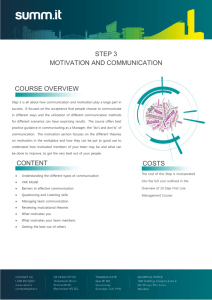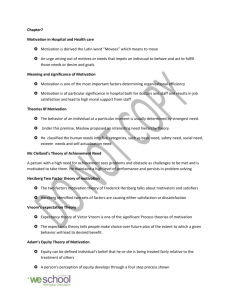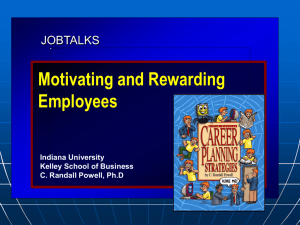Motivation - PreparationForHEcourseCLLUniversityofHull
advertisement

Motivation Motivation • Carrot or stick based motivation. • People are internally or externally motivated. • What motivates one person may not motivate another. Motivation – the extremes? COMPLIANCE COOPERATION COMMITMENT The Plodder The Enthusiast Little Enthusiasm Little Motivation High enthusiasm High Motivation But remember the old parable of the tortoise and the hare… • The slow plodder often gets there in the end • The enthusiast may get bored with implementation and routine run of the mill work; not stick with it and may lose initial enthusiasm KEY PRINCIPLES FOR MOTIVATING OTHERS • Be motivated yourself • If you are not fully committed and enthusiastic, how can you expect others to be? • Select people who are highly motivated • It is not easy to motivate the un willing ! It’s easier to motivate the positive, enthusiastic go getters! • Set realistic and challenging targets • The better the team and its targets the more individual individual members, will respond to objectives that stretch them - providing they are realistic KEY PRINCIPLES FOR MOTIVATING OTHERS • Remember that progress motivates • If you never give people feedback on how they are progressing, you will soon de-motivate them • Provide fair rewards • Not easy. Do you reward the whole team, or each individual, or both? Either way, the perception of unfair rewards certainly works against motivation KEY PRINCIPLES FOR MOTIVATING OTHERS • Give recognition where it’s due and when it’s appropriate • Costs you nothing other than time, but praise and recognition based upon actual (not perceived but actual) performance are vital Skill/Will Matrix Low Skill High will You need to guide them High Skill High Will Delegate to them ?! Low Skill Low Will You need to direct them High Skill Low Will You need to motivate them MOTIVATION Vroom’s Expectancy Theory • Vroom identifies human behaviour as being a function of two factors: 1 The perceived value of the reward that behaviour yields. 2 The expectation in the individual that certain behaviour actually will yield that reward. Vroom’s Expectancy theory • In choosing between alternative behaviours a person will choose the behaviour which will result in their achieving the more valuable output or reward, provided that they see the reward as being attainable. • The good project manager needs to convince people that the project and their part of the project is do-able and that there is a reward for doing it, and that they are expected to do it. Using Vroom’s Expectancy theory to motivate • To use the theory to motivate staff you need to ensure that the desired performance will be rewarded and that the reward will be valued by the individual and that the individual perceive sit as being achievable. (Similar theories by LW Porter and EE Lawler. Known as expectancy theories of motivation). Five step process: Using Vroom’s Expectancy theory Step 1 Define the expectations. - i.e. be clear what is required in order to receive the award. Step 2 Make the work valuable to the individual. People work to achieve personal goals (e.g. £, challenge, recognition). If employees believe and see that working towards a goal(s) will also help them attain personally valuable goals then their commitment will be higher. Try and match work to the person’s own drives and preferences. Using Vroom’s Expectancy theory Step 3 Make the work achievable. Fear of failure is often demoralising and leads to stress. Step 4 Provide regular feedback. Step 5 Reward employees when they meet expectations. External rewards can reinforce internal ones. MOTIVATION - Herzberg Herzberg’s Two Factor Theory Frederick Herzberg believed that workers became more productive when they were given greater responsibility for carrying out a complete task. His theory defined two types of factor: one which motivates and the other which merely satisfies, but does not drive behaviour. MOTIVATION - Herzberg Motivating factors (Growth factors) • • • • • Factors related to the job itself Achievement Responsibility Potential for growth The work itself / intrinsic nature of the job MOTIVATION - Herzberg Hygiene Factors (maintenance factors) – don’t motivate but their absence can cause dissatisfaction. • Work relationships • £ salary* (but may be a short term motivator and it might allow us to purchase something which does act as a personal motivator) • • • • Personal Life Status Security Company Policy and Administration / rules & regulations GOAL Theory • Basic premise of Goal Theory is that people’s goals or intentions play an important part in determining their behaviour. • The implication of that is that you need to find out what motivates each individual; and act accordingly… Maslow’s Hierarchy of Needs • • 1. 2. 3. 4. 5. See any sociology or general management textbook. (e.g. L.J. Mullins 2005 pages 480-483) 5 needs in the hierarchy Self actualisation Esteem Love Safety Physiological Not necessarily a fixed order to the hierarchy, but lower level needs must be satisfied before higher needs can be considered. Alderfer’s modified needs model • Has 3 levels of need: • Existence needs – sustaining human existence & survival. • Relatedness needs – relationships & social environment, sense of belonging. • Growth needs – development of potential, self esteem, self-actualization. Unlike Maslow’s theory Alderfer’s model says that more than one level can be activated at the same time, and that people can progress backwards down the hierarchy. Exercise • What motivates you? Produce a list identifying what motivates you. • What demotivates you? Produce a list • Choose 2 people who you manage. • What motivates them? • What evidence do you have for this? i.e how do you know? Enthusiast, Negativist or Realist? Is the glass half full; or half empty? Exercise Positive or negative person? • How might you deal with an excessively positive team member or member of staff? • How might you deal with an excessively negative team member or member of staff? How might you deal with excessive exuberance or excessive negativity/caution? Is the glass half full or half empty? • Is the person generally positive or negative? • If positive – channel that energy & enthusiasm to motivate and inspire others. • If negative find out specifics: • their life?, • their whole job? • Specific parts of their job? Motivational theory • Rational economic man: • Motivated by self-interest and external reward. • Management strategy to use – payment of individual bonus. • Authors: Taylor, Gilbert. Motivational theory • Social man: • Motivated by social needs and sense of identity. • Management strategy – group bonus and consultation. • Authors Elton Mayo Motivational theory • Self-actualising man: • Motivated by intrinsic rewards, selffulfilment, personal growth. • Management strategy – job enrichment. • Authors Maslow, Herzburg, McGregor, Arygris Motivational theory • Complex man: • Motivators vary with circumstances. • Management strategy – you have to vary it according to the circumstances. No one style strategy will work the same way different individuals. • Authors contingency varied theorists






